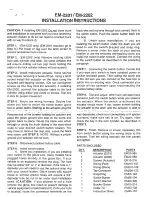
Adaptive Cruise Control
37
- When the vehicle in front is
not directly ahead of your
vehicle and is shifted to
one side
- When there is an obstacle
at the side of the road
- When the relative speed
difference compared to the
vehicle in front is large
- When a vehicle cuts into
your lane in front of you
- When the distance between
vehicles is extremely short
- When your vehicle is drift-
ing within the lane
- When driving on a bumpy
or unpaved road surface
- When driving on a road
with extremely narrow
lanes, such as when traffic
restrictions are in effect or in areas where construction work is taking
place
- When normal driving has become compromised due to an accident or
malfunction
- When extremely heavy cargo is loaded in the cargo area, rear seat or
trunk of your vehicle
•
There are limits to the situation judgment capabilities of the Adaptive
Cruise Control system. Deceleration may not take place in time in the fol-
lowing situations. Apply the brake pedal to decelerate the vehicle if neces-
sary.
- When the difference of the speeds is large or rapid deceleration occurs
even though your vehicle system recognizes the presence of a vehicle in
front
- When your vehicle is cruising by following the vehicle in front and that
vehicle decelerates slowly and then decelerates rapidly
•
If the buzzer sounds frequently, do not use Adaptive Cruise Control.
•
Even when the following distance is short, the “Obstacle Detected” warn-
ing may not activate in the following cases.
- When the relative speed difference compared to the vehicle in front is
small (the two vehicles are travelling at almost the same speed)
- When the vehicle in front is travelling faster than your vehicle (the follow-
ing distance is gradually increasing)
- When another vehicle cuts into your lane very close to your vehicle
- When the vehicle in front decelerated suddenly
- When there are repeated uphill and downhill grades
S02050
S02051
B1302AE-A.book 37 ページ 2016年8月26日 金曜日 午後2時37分
















































